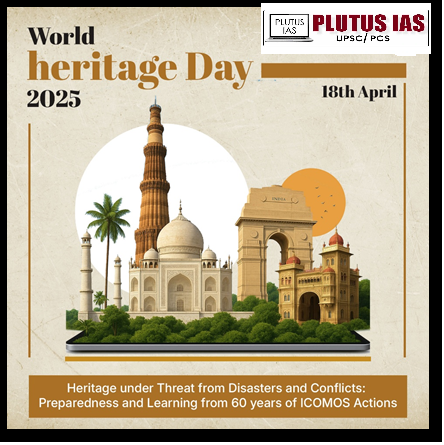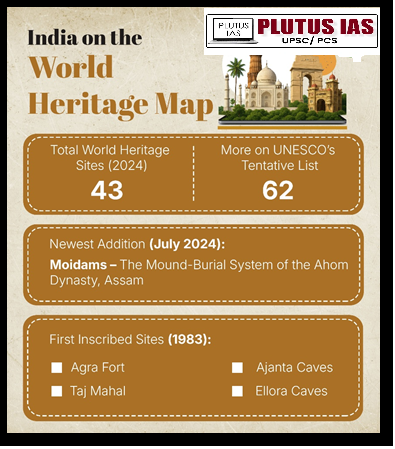23 Apr India’s Journey of Heritage Preservation
This article covers “Daily Current Affairs” and the Topic of India’s Journey of Heritage Preservation.
SYLLABUS MAPPING:
GS-1-Culture- India’s Journey of Heritage Preservation
FOR PRELIMS
What is World Heritage Day? Why is it important for a country like India to protect its World Heritage Sites
FOR MAINS
Why is cultural and natural heritage important for a country? How can India use its heritage for tourism and development?
Why in the News?
World Heritage Day, also known as the International Day for Monuments and Sites, was celebrated on 18th April 2025 with the theme “Heritage under Threat from Disasters and Conflicts: Preparedness and Learning from 60 years of ICOMOS Actions.” The day highlights the importance of preserving cultural and natural heritage worldwide, especially in the face of increasing risks from climate change, natural disasters, and conflicts. The World Heritage Convention, adopted by UNESCO in 1972, aims to safeguard such sites. As of October 2024, there are 1,223 World Heritage Sites across 196 countries, including 43 in India. Iconic Indian sites such as the Taj Mahal, Agra Fort, and Ajanta and Ellora Caves were among the first to be listed in 1983, reflecting India’s rich cultural legacy and global commitment to heritage conservation.

The Story Behind World Heritage Day
World Heritage Day is celebrated every year on 18th April. It is also called the International Day for Monuments and Sites. The day is meant to honour and protect human heritage. It also appreciates the people and groups who work to preserve it. The day was started in 1982 by ICOMOS (International Council on Monuments and Sites). Later, in 1983, UNESCO officially adopted it. Every year, ICOMOS gives a special theme for the day. Based on this theme, people and groups hold events and activities around the world to celebrate and protect heritage.
Understanding the World Heritage Convention
UNESCO, which stands for the United Nations Educational, Scientific and Cultural Organisation, works to protect and preserve important cultural and natural heritage around the world. To help with this, UNESCO’s member countries adopted the World Heritage Convention in 1972. This agreement explains what countries need to do to find and take care of special sites that can be added to the World Heritage List. India became part of this Convention in November 1977. Today, the World Heritage List includes 1,223 sites that are considered valuable to all of humanity. These include 952 cultural sites, 231 natural sites, and 40 sites that have both cultural and natural importance. As of October 2024, 196 countries have joined the World Heritage Convention.

World Heritage Sites in india
World Heritage Sites are special places on Earth that have great value for all of humanity. These can be cultural, natural, or a mix of both. They are protected under an international agreement led by UNESCO. UNESCO gives the World Heritage title to places that are culturally, historically or scientifically important. Over the years, India has steadily expanded its presence on the World Heritage List. In July 2024, a proud addition was made with the inscription of “Moidams: The Mound-Burial System of the Ahom Dynasty” from Assam as a cultural property. With this, India now has 43 sites on the World Heritage List and 62 more on UNESCO’s Tentative List. The country’s journey began in 1983 with the listing of Agra Fort, followed by the Taj Mahal, Ajanta Caves and Ellora Caves. These sites are preserved not only as symbols of history but also as learning spaces for generations to come.

Government’s Initiatives to Promote India’s Rich Cultural Heritage

1. Retrieval of Antiquities: The Archaeological Survey of India is committed to the protection of cultural property. The government has retrieved 655 antiquities from foreign countries from the year 1976 to 2024, of which 642 antiquities have been retrieved since 2014.
2. Adopt a Heritage’ Scheme: The “Adopt A Heritage” programme was launched in 2017 and revamped as “Adopt A Heritage 2.0” in 2023. It allows private and public groups to help develop facilities at protected monuments using their Corporate Social Responsibility (CSR) funds.
3. 46th Session of the World Heritage Committee: Archaeological Survey of India, Ministry of Culture, successfully hosted the 46th Session of the World Heritage Committee in Delhi from 21st to 31st July 2024. The meeting was inaugurated by the Prime Minister and attended by nearly 2900 international and national delegates from more than 140 countries.
4. Building Monuments of National Importance: India has 3,697 ancient monuments and archaeological sites declared of national importance. The Archaeological Survey of India (ASI) is responsible for their conservation and maintenance.
5. Revival and Redevelopment of Heritage Sites: India has revived key heritage sites through conservation and development projects. The Kashi Vishwanath Corridor in Varanasi, Mahakaal Lok in Ujjain, and Ma Kamakhya Corridor in Guwahati enhance pilgrim experiences and boost tourism.
6. Must-See Portal: The Archaeological Survey of India (ASI) has created a portal to showcase “Must-See Monuments and Archaeological Sites of India.” It highlights nearly a hundred prominent sites, including World Heritage properties and UNESCO Tentative List
7. Digitisation of Cultural Heritage in India: The National Mission on Monuments and Antiquities (NMMA), set up in 2007, works to digitise and document India’s heritage and antiquities. So far, over 12.3 lakh antiquities and 11,406 heritage sites have been recorded. For 2024–25, ₹20 lakh was allocated to the mission.
8. Status of Classical Languages: On October 3, 2024, the Government granted classical language status to Assamese, Marathi, Pali, Prakrit, and Bengali, raising the total to 11 classical Indian languages. This move reflects India’s strong commitment to preserving its diverse and ancient linguistic heritage.
9. India’s first Archaeological Experiential Museum: Union Minister Amit Shah inaugurated the Archaeological Experiential Museum in Vadnagar on 16th January 2025. Built at a cost of ₹298 crore, the museum covers 12,500 square meters. It showcases Vadnagar’s 2,500-year-old history with over 5,000 artefacts, including ceramics, coins, tools and skeletal remains.
10. Humayun’s Tomb World Heritage Site Museum: On 29th July 2024, a state-of-the-art museum spanning 100,000 square feet was inaugurated at Humayun’s Tomb, a UNESCO World Heritage Site in New Delhi. The museum showcases the site’s rich history, architecture, and conservation journey, offering visitors an immersive cultural experience.
11. India’s Literary Milestone on the MOWCAP Register: In a historic achievement, three of India’s literary treasures- Ramcharitmanas, Panchatantra, and Sahrdayāloka-Locana- were inscribed into the 2024 Memory of the World Committee for Asia and the Pacific (MOWCAP) Regional Register.
Challenges
1. Natural Disasters & Climate Change: Earthquakes, floods, and rising sea levels threaten structural integrity and ecosystems.
2. Conflict & Vandalism: Wars, insurgencies, and theft damage or destroy heritage sites and artefacts.
3. Urbanisation & Encroachment: Rapid development near sites leads to pollution, illegal construction, and visual degradation.
4. Pollution: Air, water, and noise pollution erode monuments and disturb natural heritage areas (e.g., Taj Mahal).
5. Unregulated Tourism: Overcrowding causes wear and tear, especially at fragile heritage spots like Ajanta-Ellora.
6. Funding & Skill Shortage: Many sites lack adequate financial support and trained conservation professionals.
7. Poor Documentation: Incomplete or outdated records hinder effective conservation and international recognition.
8. Lack of Coordination: Multiple agencies working in silos weaken heritage protection efforts and delay responses.
Way forward
1. Disaster-Resilient Planning: Integrate climate adaptation and disaster risk management into site conservation.
2. Stronger Legal Protection: Enforce stricter laws against encroachment, vandalism, and illegal construction.
3. Sustainable Tourism: Promote eco-friendly tourism with visitor limits, local guides, and awareness campaigns.
4. Increased Funding: Boost public and CSR-based investments for heritage maintenance and infrastructure.
5. Skilled Manpower Development: Train more heritage conservationists, archaeologists, and local caretakers.
6. Technology Use: Employ GIS, 3D mapping, drones, and AI for monitoring, restoration, and documentation.
7. Community Involvement: Engage local communities as stakeholders to ensure long-term protection and pride.
8. Global Collaboration: Strengthen ties with UNESCO, ICOMOS, and other countries to adopt global best practices.
Conclusion
Preserving World Heritage Sites is not just about protecting monuments; it is about safeguarding human history, cultural identity, and natural legacy for future generations. In the face of rising threats from disasters and conflicts, India must adopt inclusive, technology-driven, and community-led conservation models. Strengthening legal frameworks, global cooperation, and public awareness will ensure that heritage continues to educate, inspire, and unite humanity.
Download Plutus IAS Current Affairs (Eng) 23rd April 2025
Prelims Questions
Q. “World Heritage Sites are global treasures, but they face increasing threats from disasters, conflicts, and urban pressures.” Discuss the major challenges in conserving World Heritage Sites in India and suggest a roadmap for their effective protection and promotion.
(250 words, 15 marks)




No Comments